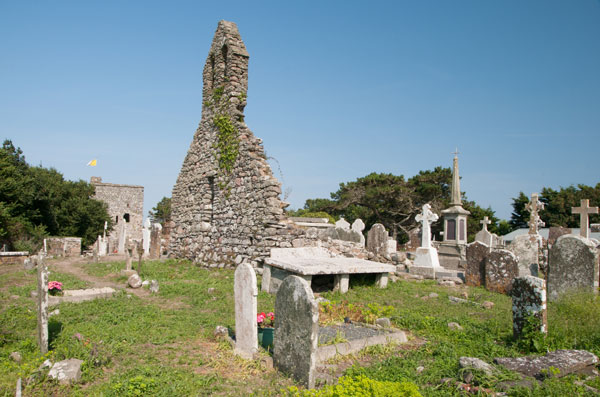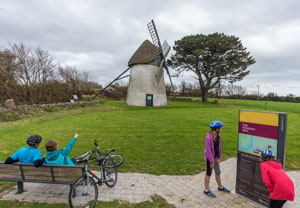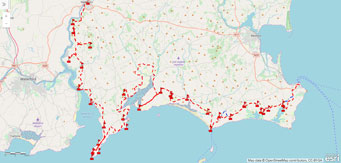MUSEUM EYE: The Norman Way
Published in Issue 3 (May/June 2019), Reviews, Volume 27County Wexford
www.thenormanway.com
By Tony Canavan
The Norman Way is a heritage trail that runs along the south coast of County Wexford. Although celebrating an episode from medieval history, the Way is very much 21st-century, as it is promoted mainly through its website and social media. There are information panels and maps along the route but no brochures or pamphlets. The website states that the Way ‘will help you to understand the Norman way of life’ but is also quite clear that its main purpose is to support tourism and help local businesses, as there are links to local restaurants and accommodation.
The Way can be explored on foot, by bicycle or by car and passes through beautiful countryside, charming seaside villages and stunning beaches, all of which are worth visiting. Cycling in particular is encouraged, as the Eurovelo 1 Atlantic Coast cycling route actually follows the course of the Norman Way. Cars are encouraged in some places to take an alternative road so as to ensure the quality of the cycling route. Eurovelo 1 is an Atlantic Coast Route stretching c. 9,100km from Norway to Portugal (eurovelo.com/en/eurovelos/eurovelo-1).

Above: Lady’s Island—a place of pilgrimage and medieval ruins.
From a historian’s point of view, the presentation of the Normans (setting aside questions of definition) may raise an eyebrow. From the website and information panels, one would hardly know that the Normans were invaders (admittedly the first group were invited in) whose arrival in Ireland was characterised by violence. Instead, the Normans are portrayed as if they were modern-day immigrants:
‘As generations of Normans made their home here, their Norman way of doing things enhanced everyday life in Ireland. Travel along the Norman Way in Wexford to meet the descendants of those Normans and to discover how the Normans: constructed formidable buildings on this landscape; improved agriculture and food production here; supported a change in the character of the Christianity practised in the country; and enhanced military know-how and navigation in Ireland.’
I am not so sure that Irish lords or churchmen displaced by the Normans or Irish peasants finding themselves under Norman lordship would agree that their everyday life had been enhanced.
The Way has two sections: the first includes the ten finished sites from Lady’s Island to Kilmore Quay, approximately 22km, and the second (to be completed) runs between Kilmore Quay and St Mary’s Church, New Ross, approximately 43km. Questions might be asked as to why work was finished on the Lady’s Island–Kilmore Quay section first, as this leaves out the most significant site, Baginbun, where the first group of Normans landed. As the rhyme has it, ‘At Baginbun, Ireland was lost and won’.

Above: Cyclists at Tacumshane windmill—the Normans introduced this technology.
On the completed section of the route, however, there are indeed Norman treasures, such as Lady’s Island itself (a place of pilgrimage and medieval ruins), Tacumshane windmill (because the Normans introduced this technology), Sigginstown Castle and Tomhaggard (originally a Norman village). All these sites have information panels and bike racks. Beyond this, other sites (as yet without panels and racks) which you can visit include Tintern Abbey, Loftus Hall (not actually Norman but linked to Norman ancestry), Coolhull Castle and of course the aforementioned Baginbun.
The purist might rightly point out that many sites on the Way have only a tenuous connection with the Normans, often dating from a period when ‘Norman’ as a distinct identity no longer existed. We should bear in mind, however, that this is not a textbook or a history lesson but is primarily a tourist project. The underlying purpose of the Norman Way is to exploit the idea of the Normans in Ireland in order to attract visitors, preferably from abroad. To that end, some glossing over of reality may be required, although such an approach may be self-defeating. I was with some American friends who guffawed at the idea of the Normans as immigrants who enhanced the Irish way of life (and also at other places which present the Vikings as ‘settlers’, it must be said). The designers of the Norman Way seem to assume that visitors know little history.

Above: A screenshot of the map on the Norman Way website.
My main gripe with the route is the practical one that not all sites live up to their billing—St Iberius Church, for example, is disappointing. My companion and I decided to walk from Lady’s Island to Kilmore but went off the Norman Way thanks to a sign pointing in the wrong direction. If travelling by bike or car, it’s no big deal to turn round after a few kilometres to get back on the right road, but doing so on foot is another matter.
Nevertheless, despite any misgivings, I enjoyed my time on the Norman Way. This is a historic part of the country worth visiting in any case. And I don’t particularly object to its portrayal of the Normans. I have to admit to having a soft spot for them. They were a remarkable people whose influence stretches from Ireland to the Black Sea. I am glad that Ireland is part of their story—and if they did arrive as invaders, did they not become Hiberniores Hibernis ipsis?
Tony Canavan is editor of Books Ireland.
















